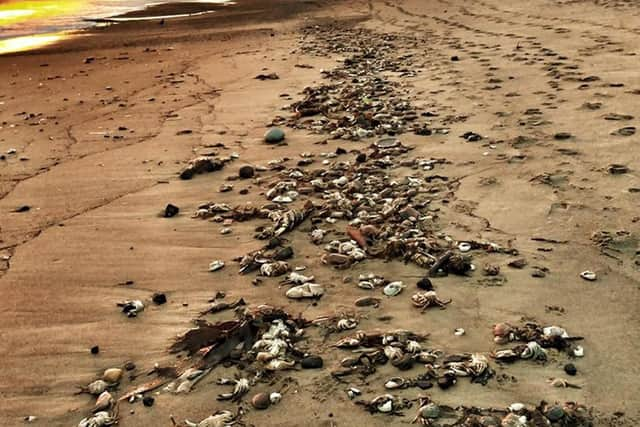New investigation into crab deaths in Yorkshire finds disease is ‘most likely cause’


They found a naturally-occurring algal bloom, which was identified as the most likely cause by the Government’s original investigation, is “unlikely” to have caused the deaths and it is “very unlikely” that dredging or toxic chemicals are to blame.
There does not appear to be a “single clear cause” but the crabs may have been killed by a mysterious disease, according to the panel, which was convened by the Department for Environment Food and Rural Affairs (Defra) to carry out an independent review.
Advertisement
Hide AdAdvertisement
Hide AdThe crustaceans began washing ashore in October 2021, between Hartlepool and Whitby, and local campaigners and scientists from several universities in the North have said that a toxic industrial chemical called pyridine may be responsible.


They claimed that large quantities of the chemical was trapped in sediment in the river bed, until it was churned up by dredging done as part of the Government-backed Teeside freeport project.
Professor Gideon Henderson, Defra’s Chief Scientific Advisor who chaired the panel, said: “We are not able to point to any individual single cause and be definitive about it.
“But I think we are able to really point to some things that it was not. It's very unlikely to be caused by dredging or pyridine toxicity.”
Advertisement
Hide AdAdvertisement
Hide AdTees Valley Mayor Ben Houchen said the panel’s report “exonerates” the freeport and shows “the work we are doing is completely safe”.
But Alex Cunningham, Labour MP for Stockton North, said "the matter is very much not closed" and a "fully independent” investigation is needed to "get to the bottom of this environmental tragedy".
In their report, the panel of scientists stated that a disease or parasite that is new to UK waters is "the most likely cause" of the deaths, but “no significant pathogens were identified” because full molecular screening was not conducted during the initial investigation, which involved several Government agencies and was led by Defra.
According to the panel, there are three factors which suggest a disease or parasite is the cause: only crustaceans died, they were found across a large area – around 70km of coastline – and some were twitching when they were discovered.
Advertisement
Hide AdAdvertisement
Hide AdDr Tammy Horton, Research Scientist, National Oceanography Centre, said: “If there was a novel pathogen in the UK then it is likely that it will remain part of the UK fauna. It is unlikely to disappear, but whether a mass mortality on the scale of this would happen again, we can't say.”
The panel of scientists found no pyridine was detected in the water and the amount of pyridine found in dredged material was not high enough to kill crabs.
They said maintenance dredging was carried out in October, when the deaths occurred, but the amount of toxic chemicals released was “significantly too small to cause crab mortality”.
It is also “exceptionally unlikely” that capital dredging, done to increase the port’s capacity, is the cause because it was carried out 10 months before and then 11 months after the mass die off began, the panel added.